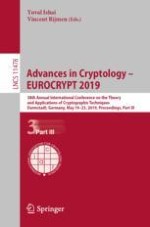2019 | OriginalPaper | Buchkapitel
Group Signatures Without NIZK: From Lattices in the Standard Model
verfasst von : Shuichi Katsumata, Shota Yamada
Erschienen in: Advances in Cryptology – EUROCRYPT 2019
Aktivieren Sie unsere intelligente Suche, um passende Fachinhalte oder Patente zu finden.
Wählen Sie Textabschnitte aus um mit Künstlicher Intelligenz passenden Patente zu finden. powered by
Markieren Sie Textabschnitte, um KI-gestützt weitere passende Inhalte zu finden. powered by
Abstract
-
Our first construction is proven secure assuming the standard LWE and the SIS assumption. The sizes of the public parameters and the signatures grow linearly in the number of users in the system.
-
Our second construction is proven secure assuming the standard LWE and the subexponential hardness of the SIS problem. The sizes of the public parameters and the signatures are independent of the number of users in the system.
